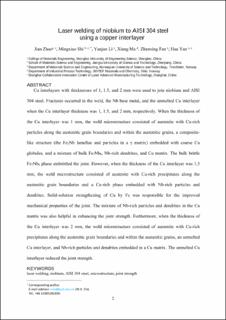| dc.description.abstract | Cu interlayers with thicknesses of 1, 1.5, and 2 mm were used to join niobium and AISI 304 steel. Fractures occurred in the weld, the Nb base metal, and the unmelted Cu interlayer when the Cu interlayer thickness was 1, 1.5, and 2 mm, respectively. When the thickness of the Cu interlayer was 1 mm, the weld microstructure consisted of austenite with Cu-rich particles along the austenitic grain boundaries and within the austenitic grains, a composite-like structure (the Fe2Nb lamellae and particles in a γ matrix) embedded with coarse Cu globules, and a mixture of bulk Fe7Nb6, Nb-rich dendrites, and Cu matrix. The bulk brittle Fe7Nb6 phase embrittled the joint. However, when the thickness of the Cu interlayer was 1.5 mm, the weld microstructure consisted of austenite with Cu-rich precipitates along the austenitic grain boundaries and a Cu-rich phase embedded with Nb-rich particles and dendrites. Solid-solution strengthening of Cu by Fe was responsible for the improved mechanical properties of the joint. The mixture of Nb-rich particles and dendrites in the Cu matrix was also helpful in enhancing the joint strength. Furthermore, when the thickness of the Cu interlayer was 2 mm, the weld microstructure consisted of austenite with Cu-rich precipitates along the austenitic grain boundaries and within the austenitic grains, an unmelted Cu interlayer, and Nb-rich particles and dendrites embedded in a Cu matrix. The unmelted Cu interlayer reduced the joint strength. | en_US |
